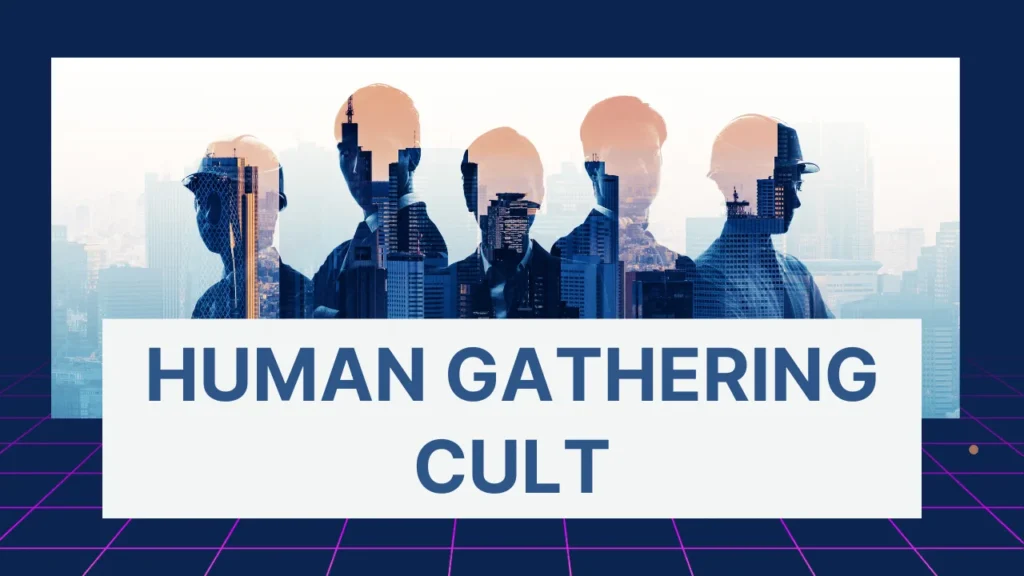Human Gathering Cult [Is it Fake or Real?]

Human gathering cults, often shrouded in mystery and misconceptions, encompass a diverse range of communities united by collective experiences, shared beliefs, and communal living. While the term “cult” often carries a negative connotation, many of these groups foster positive values like compassion, self-discovery, and communal support. This article delves into the essence of human gathering cults, their historical roots, characteristics, and the fine line between benign and harmful practices.
Origins of Human Gathering Cults
Spiritual Movements
Spiritual movements have long been a cornerstone of human gathering cults. These movements often emerge from a collective desire for deeper meaning and connection to a higher power. Historically, spiritual movements have ranged from ancient religious gatherings to contemporary spiritual retreats, each aiming to foster a sense of community and shared purpose among their members.
Countercultural Revolutions
Countercultural revolutions challenge the status quo and promote alternative ways of living. During the 1960s and 70s, movements such as the hippie movement exemplified this trend. These groups sought to create utopian societies based on principles of peace, love, and communal living, often in direct opposition to mainstream societal norms.
Utopian Experiments
Utopian experiments aim to create ideal societies based on specific philosophical or social ideals. Examples include historical communities like the Oneida Community in the 19th century, which practiced complex marriage and communal property. These experiments often serve as a blueprint for modern intentional communities seeking to achieve a harmonious and sustainable way of life.
Egalitarian Communities
Egalitarian communities prioritize equality and shared decision-making among members. These communities often operate on principles of participatory democracy, ensuring that every member has a voice in communal decisions. This approach contrasts sharply with traditional hierarchical structures found in many organizations.
Participatory Decision-Making
Participatory decision-making is a hallmark of many human gathering cults. This process involves collective deliberation and consensus-building, ensuring that decisions reflect the group’s collective will. This method promotes inclusivity and empowers members, fostering a sense of ownership and commitment to the community’s goals.
Characteristics of Human Gathering Cults
Collective Experiences
Human gathering cults thrive on collective experiences that bind members together. Whether through rituals, ceremonies, or communal activities, these shared experiences create strong emotional bonds and a sense of belonging. Large-scale events like Burning Man exemplify how collective experiences can foster deep connections among participants.
Shared Beliefs
Shared beliefs are the foundation of any human gathering cult. These beliefs provide a common framework that guides the group’s actions and interactions. Whether spiritual, philosophical, or social, these beliefs help create a cohesive identity and purpose for the community.
Communal Living
Communal living arrangements are common in human gathering cults, where members share resources, responsibilities, and daily life. This lifestyle promotes interdependence and mutual support, often enhancing the community’s resilience and sustainability.
Cultural Unity
Cultural unity is achieved through practices and traditions that reinforce the group’s identity and values. This unity is often expressed through symbols, language, and rituals unique to the community, helping to distinguish it from the broader society.
Alternative Cultural Expressions
Alternative cultural expressions are a key feature of many human gathering cults. These groups often embrace unconventional art, music, and lifestyle choices as a means of self-expression and resistance to mainstream culture. This diversity enriches the community and attracts individuals seeking a unique and meaningful way of life.
Positive Aspects of Human Gathering Cults
Compassionate Communities
Many human gathering cults emphasize compassion and mutual support. These communities provide a nurturing environment where members can find emotional and practical support, fostering a sense of security and well-being.
Self-Discovery Groups
Self-discovery is a central theme in many human gathering cults. Through various practices, such as meditation, workshops, and communal activities, members are encouraged to explore their inner selves and develop a deeper understanding of their purpose and potential.
Sustainability-Focused Groups
Sustainability is a common goal in many human gathering cults. These communities often prioritize ecological practices, such as organic farming, renewable energy, and waste reduction, aiming to live in harmony with the environment and promote a sustainable future.
Personal Growth Communities
Personal growth is a key focus in many human gathering cults. Through continuous learning, skill development, and personal challenges, members are encouraged to grow and evolve, both individually and collectively.
Supportive Human Gatherings
Supportive human gatherings create a safe space for individuals to express themselves and receive validation and encouragement from the community. This supportive environment can be particularly beneficial for individuals seeking recovery from trauma or personal challenges.
Dangers and Challenges of Human Gathering Cults
Psychological Manipulation
Some human gathering cults engage in psychological manipulation, exerting control over members through tactics such as coercion, isolation, and indoctrination. This manipulation can lead to a loss of autonomy and critical thinking among members.
Financial Exploitation
Financial exploitation is a risk in some human gathering cults. Leaders or core members may exert undue influence over financial resources, leading to exploitation and financial dependence among members. High-profile cases like the Jonestown massacre and Heaven’s Gate highlight the potential dangers of financial exploitation in such groups.
Controlling Behavior
Controlling behavior is a hallmark of many harmful human gathering cults. Leaders may impose strict rules and regulations, limiting personal freedoms and enforcing conformity. This control can extend to personal relationships, work, and even thoughts, creating a highly restrictive environment.
Manipulative Cults
Manipulative cults often use deceptive practices to recruit and retain members. These practices can include false promises, misrepresentation of the group’s true nature, and emotional manipulation. Members may find themselves trapped in an environment that is difficult to leave.
Community Authenticity Challenges
Maintaining authenticity in human gathering cults, especially in the digital age, can be challenging. Virtual assemblies and online communities often struggle to create the deep connections and genuine interactions that characterize traditional, in-person gatherings.
Modern Context and Digital Gatherings
Digital Gathering Communities
The rise of digital gathering communities has transformed the landscape of human gathering cults. Online platforms allow for greater accessibility and inclusivity, enabling people from diverse backgrounds to connect and form communities. However, these digital gatherings also face challenges in creating deep, meaningful connections.
Virtual Assembly Groups
Virtual assembly groups, facilitated by social media and other digital tools, have become increasingly popular. These groups offer a space for like-minded individuals to share ideas, support each other, and organize collective actions. While they offer convenience and reach, maintaining authenticity and engagement in virtual settings can be difficult.
Supportive Human Gathering
Supportive human gatherings in the digital realm can provide a sense of community and belonging, especially for individuals who may feel isolated in their physical environments. These virtual communities can offer emotional support, resources, and a sense of purpose.
Personal Growth in Digital Communities
Personal growth communities online can provide valuable opportunities for learning and development. Through webinars, online courses, and virtual workshops, members can acquire new skills, gain insights, and connect with mentors and peers.
Community Authenticity Challenges
Despite the benefits of digital gatherings, maintaining authenticity and deep connections in virtual communities remains a significant challenge. The lack of face-to-face interactions can hinder the development of trust and genuine relationships, which are crucial for a supportive and cohesive community.
How to Critically Assess a Community
Informed Participation
Informed participation is crucial when considering joining any community, especially a human gathering cult. Potential members should thoroughly research the group’s beliefs, practices, and leadership structure, ensuring they align with their values and goals.
Understanding Community Dynamics
Understanding the dynamics of a community can help individuals make informed decisions. This includes evaluating the decision-making processes, power structures, and the level of transparency and accountability within the group.
Assessing Leadership and Authority
Assessing the leadership and authority within a community is vital. Potential members should look for signs of healthy leadership, such as transparency, accountability, and a participatory approach, as opposed to authoritarian or manipulative behaviors.
Evaluating Financial Practices
Evaluating the financial practices of a community can reveal much about its ethical standards and potential risks. Transparency in financial matters, fair distribution of resources, and voluntary contributions are positive indicators, whereas coercive or opaque financial practices can be red flags.
Seeking Testimonials and References
Seeking testimonials and references from current or former members can provide valuable insights into the community’s practices and culture. These firsthand accounts can help potential members understand the reality of life within the group and identify any potential concerns.
Frequently Asked Questions
What Defines a Human Gathering Cult?
A human gathering cult is defined by its emphasis on collective experiences, shared beliefs, and communal living. These groups often prioritize participatory decision-making and egalitarian principles, distinguishing them from traditional cults with hierarchical structures.
How Do Intentional Communities Function?
Intentional communities function based on shared values and goals. Members often live and work together, sharing resources and responsibilities. Decision-making is typically participatory, with an emphasis on consensus and collaboration.
What Are the Positive Aspects of Human Gathering Cults?
Positive aspects of human gathering cults include fostering a sense of community and belonging, promoting personal growth, and encouraging sustainable living practices. These communities often provide a supportive environment for self-discovery and mutual support.
How to Identify Manipulative Cults?
Identifying manipulative cults involves looking for signs of coercion, financial exploitation, and controlling behavior. Red flags include strict rules, authoritarian leadership, isolation from outside influences, and deceptive recruitment practices.
What Are the Differences Between Traditional and Human Gathering Cults?
Traditional cults often revolve around a single charismatic leader and employ hierarchical structures, while human gathering cults typically prioritize egalitarian principles and participatory decision-making. Human gathering cults focus on collective experiences and shared beliefs, fostering a sense of community and mutual support.
Also Read: Do Alec and Kaleb Get Paid for Commercials?
Conclusion
In conclusion, understanding the complexities and diversity of human gathering cults requires a nuanced perspective. While some communities offer positive environments that promote personal growth and collective well-being, others may engage in harmful practices. It is essential for individuals to critically assess any group they consider joining, ensuring their involvement is based on informed and voluntary participation. By doing so, they can make empowered choices and contribute to fostering supportive and thriving communities.


